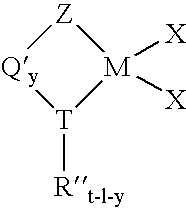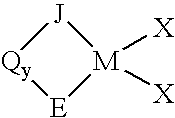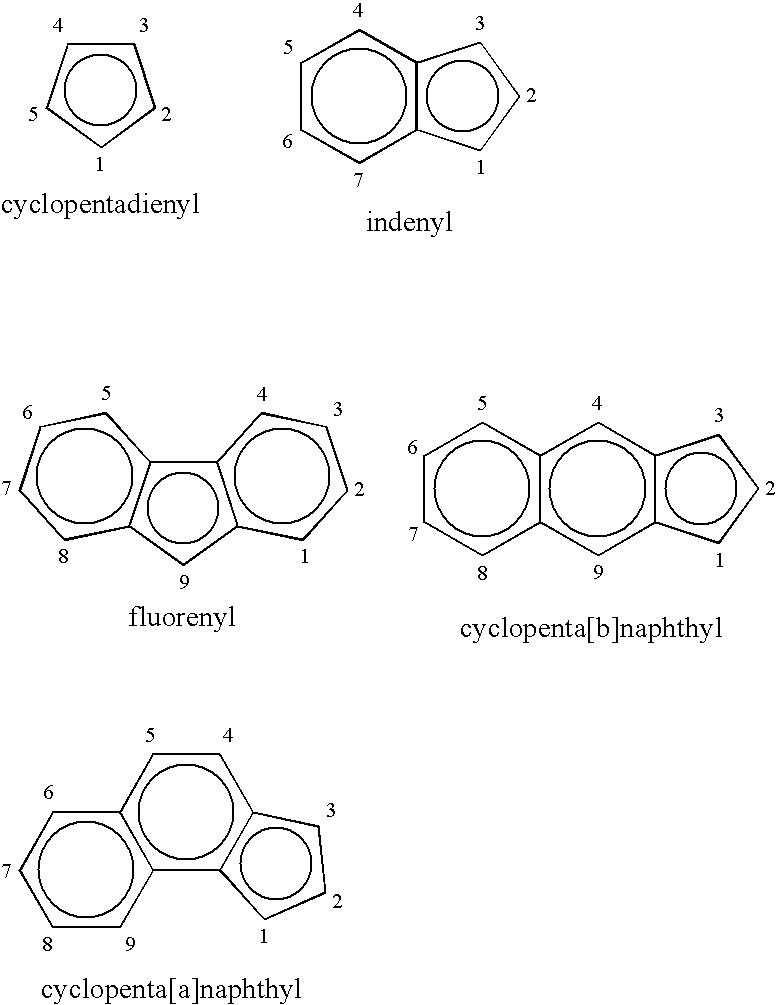Process for producing substituted metallocene compounds for olefin polymerization
- Summary
- Abstract
- Description
- Claims
- Application Information
AI Technical Summary
Benefits of technology
Problems solved by technology
Method used
Image
Examples
example 1a
(η5-2,4-dimethylindenyl)(η5-pentamethylcyclopentadienyl)zirconium dichloride (1a)
[1787] In a 16 ml vial equipped with a PTFE coated stir bar, to a suspension of 300 mg (0.59 mmol) of 1 in 8.0 ml of THF, 0.39 ml of 2.0 M MeZnCl (0.78 mmol) in THF and 0.59 ml of 0.02 M (0.012 mmol) Pd(PtBu3)2 in THF were added by a dosing pipette. The reaction mixture was stirred for 4 hours at room temperature and then evaporated to dryness. To the residue, a solution of 1.0 ml of MeSiCl3 in 10 ml of dry dichloromethane was added to eliminate an excess of the organozinc reagent. The resulting mixture was stirred at ambient temperature for 1 hour and then evaporated to dryness. In order to eliminate THF contamination, the residue was treated with hot toluene (20 ml), then, the suspension was evaporated to dryness. The residue was additionally treated with 60 ml of hot toluene, and the resulting suspension was filtered through Celite 503. The toluene extract was evaporated to dryness. The obtained sol...
example 1c
(η5-2-methyl-4-p-tolylindenyl)(η5-pentamethylcyclopentadienyl)zirconium dichloride (1c)
[1791] In a 16 ml vial equipped with a PTFE coated stir bar, 0.79 ml of 1.0 M (0.79 mmol) p-tolylmagnesium bromide in THF was added by a dosing pipette to a mixture of 1.73 ml of 0.5 M (0.87 mmol) ZnCl2 in THF and 5 ml of THF by vigorous stirring at ambient temperature. This organozinc reagent was additionally stirred for 1 hour and then added to a mixture of 306 mg (0.61 mmol) of 1, 0.61 ml of 0.02 M (0.012 mmol) Pd(PtBu3)2 in THF, and 2 ml of THF placed in a separate 16 ml vial equipped with a PTFE coated stir bar. The reaction mixture was stirred for 4 hours at room temperature and then evaporated to dryness. To the residue, a solution of 1.0 ml of MeSiCl3 in 10 ml of dry dichloromethane was added to eliminate an excess of the organozinc reagent. The resulting mixture was stirred at ambient temperature for 1 hour and then evaporated to dryness. In order to eliminate THF contamination, the resi...
example 1c ′
EXAMPLE 1c′
(η5-2-methyl-4-p-tolylindenyl)(η5-pentamethylcyclopentadienyl)zirconium dichloride (1c)
[1795] In a 16 ml vial equipped with a PTFE coated stir bar, 0.79 ml of 1.0 M (0.79 mmol) p-tolylmagnesium bromide in THF was added by a dosing pipette to a mixture of 1.73 ml of 0.5 M (0.87 mmol) ZnCl2 in THF and 5 ml of THF by vigorous stirring at ambient temperature. This organozinc reagent was additionally stirred for 1 hour and then added to a mixture of 306 mg (0.61 mmol) of 1, 9 mg (0.012 mmol) of NiBr2(PPh3)2, and 3 ml of THF placed in a separate 16 ml vial equipped with a PTFE coated stir bar. The reaction mixture was stirred for 48 hours at room temperature and then evaporated to dryness. To the residue, a solution of 1.0 ml of MeSiCl3 in 10 ml of dry dichloromethane was added to eliminate an excess of the organozinc reagent. The resulting mixture was stirred at ambient temperature for 1 hour and then evaporated to dryness. In order to eliminate THF contamination, the residue...
PUM
| Property | Measurement | Unit |
|---|---|---|
| Temperature | aaaaa | aaaaa |
| Temperature | aaaaa | aaaaa |
| Temperature | aaaaa | aaaaa |
Abstract
Description
Claims
Application Information
 Login to View More
Login to View More - R&D
- Intellectual Property
- Life Sciences
- Materials
- Tech Scout
- Unparalleled Data Quality
- Higher Quality Content
- 60% Fewer Hallucinations
Browse by: Latest US Patents, China's latest patents, Technical Efficacy Thesaurus, Application Domain, Technology Topic, Popular Technical Reports.
© 2025 PatSnap. All rights reserved.Legal|Privacy policy|Modern Slavery Act Transparency Statement|Sitemap|About US| Contact US: help@patsnap.com



